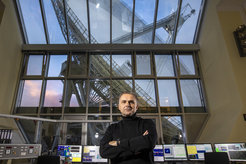Black holes as magnetic jet engines
European Research Council supports Bonn astrophysicists with 2.5 million euros to explain the phenomenon
Super-massive black holes are found at the centers of many galaxies. But all efforts to detect these mysterious objects directly suffer from the fact that no information from their interior can reach us directly. Now, astrophysicist Professor Anton Zensus, director at the Max Planck Institute for Radio Astronomy in Bonn and founding chairman of the Event Horizon Telescope collaboration (EHT), has proposed an independent method to filter out those explanations from the existing ones that are viable. At the same time, this method may succeed in explaining the high-energy plasma outflows ejected by many black holes.
The European Research Council (ERC) found the concept so compelling that it is funding it with an ERC Advanced Grant for cutting-edge research in Europe worth 2.5 million euros.

The goal of the new method is to precisely observe the magnetic fields in the immediate vicinity of a black hole's event horizon, the distance beyond which light can no longer escape. "This region is of key importance because it reflects the fundamental physics of a black hole. If we learn more about this region, we will be able to explain how the already observed plasma outflows, also called jets, are formed" says Anton Zensus. "If we understand how magnetic fields behave in the immediate vicinity of a black hole, we will have found an explanation for how the black hole drives these jets. At the same time, we will be able to rule out some alternative explanations of black holes."
Active galactic nuclei are the most extreme sources of energy in the universe. They often outshine even the entire galaxy in which they reside. Rotating supermassive black holes, their surrounding rotating gas disks, relativistic plasma jets, and magnetic fields are thought to play a central role in generating these energies and transporting them outward. However, the details of this process are still unexplored.
Relativistic plasma jets have already been imaged, through the interconnection of radio telescopes across the globe. Building on the experience of the Global mm-VLBI Array (GMVA), under leadership of the MPI für Radioastronomie since 2003, the analysis methods at the highest resolution have been refined. As a result, the Event Horizon Telescope (EHT) collaboration has also succeeded in imaging the silhouette of the putative supermassive black hole in the galaxy M87 with sufficient sensitivity and resolution to confirm theoretical predictions from general relativity.
However, to definitively prove the existence of black holes and determine their physical properties, accurate information about the magnetic field near the event horizon is required. Observing this region precisely is a major challenge that cannot be realized by improvements in GMVA and EHT imaging alone. Therefore, Anton Zensus, together with researchers at the Max Planck Institute for Radio Astronomy, has developed a novel approach.
The goal of his project, now funded by the ERC with the acronym M2FINDERS, is to further develop technical and radio astronomical methods so that magnetic fields in the vicinity of black holes can be precisely mapped. In active galactic nuclei, where black holes are suspected, the polarization of the observable radio radiation is to be determined. Polarized means radiation that oscillates in a certain plane, like a guitar string. The effect of polarization is used, for example, by some sunglasses to filter out unwanted reflections. Polarization observed in astronomical objects is a sure indication of magnetic fields. Magnetic fields determined by more advanced technologies will be combined with novel methods for image analysis and modeling of relativistic flows. This will lead to precise information about the strength and structure of the magnetic field near the event horizon and provide crucial independent evidence for the existence of black holes and their event horizons, which should complement EHT imaging.
-------------------------------------------------

Anton Zensus in the control room of the Effelsberg Radio Observatory.
Further Information
Prof. Anton Zensus: J. Anton Zensus is director of the Department of Radio Astronomy and Very-Long-Baseline Interferometry at the Max Planck Institute for Radio Astronomy in Bonn, Germany, and founding chairman of the international Event Horizon Telescope (EHT) collaboration. He studied in Münster, Cologne and Bonn and subsequently conducted research in the USA at the California Institute of Technology and the National Radio Astronomy Observatory.
In the EU project RadioNet he coordinates leading European observatories and laboratories for radio astronomy. He is also involved in promoting young scientists and serves as an honorary professor at the University of Cologne.
ERC Grants: With the Advanced Grant, the European Research Council (ERC) honors leading researchers who combine excellent research with innovative approaches. The highly endowed funding supports projects that have the potential for a scientific breakthrough in their field of research. Only about 8 percent of all project proposals are funded.

